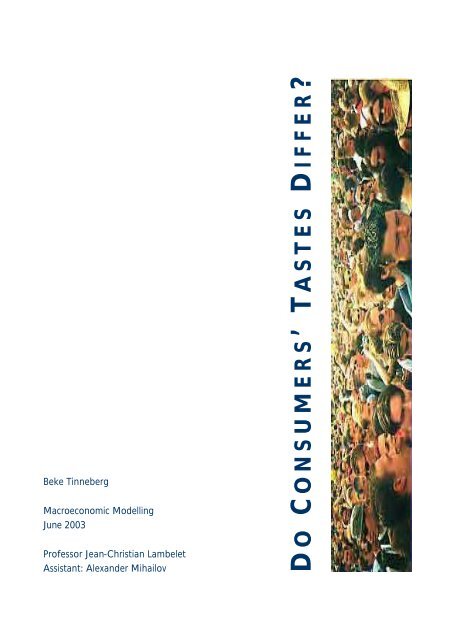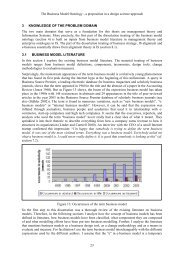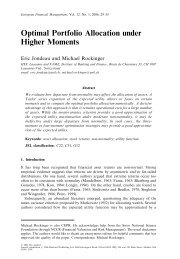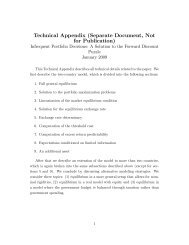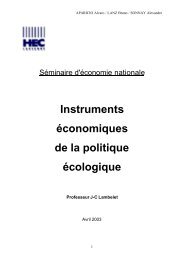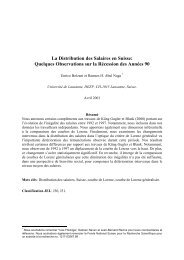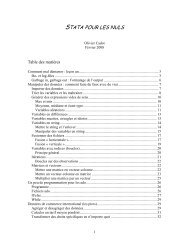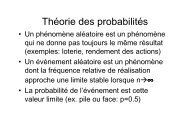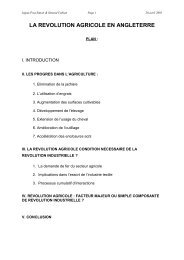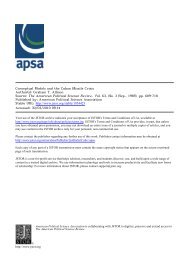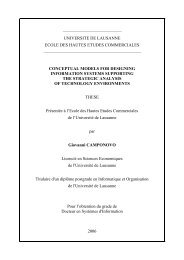Do consumer s tastes differ final 1.7. - HEC
Do consumer s tastes differ final 1.7. - HEC
Do consumer s tastes differ final 1.7. - HEC
Create successful ePaper yourself
Turn your PDF publications into a flip-book with our unique Google optimized e-Paper software.
Beke Tinneberg<br />
Macroeconomic Modelling<br />
June 2003<br />
Professor Jean-Christian Lambelet<br />
Assistant: Alexander Mihailov<br />
D O C ONSUMERS’ TASTES D IFFER?
Table of content<br />
Table of content................................................................................................... 1<br />
Introduction.......................................................................................................... 2<br />
Utility Theory and Preferences.............................................................................. 3<br />
ANALYSIS OF MARGINAL UTILITY ................................................................................................................... 3<br />
ANALYSIS OF INDIFFERE NCE CURVES............................................................................................................... 3<br />
ANALYSIS OF REVEALED PREFERENCES ............................................................................................................. 3<br />
Literature and preferences.................................................................................... 5<br />
S. SELVANATHAN: A SYSTEM-WIDE ANALYSIS OF INTERNATIONAL CONSUMPTION AND TRADE........................................ 5<br />
CLEMENTS/CHEN: FUNDAMENTAL SIMILARITIES IN CONSUMER BEHAVIOUR................................................................ 8<br />
G.S. BECKER: ACCOUNTING FOR TASTES...................................................................................................... 12<br />
Personal capital......................................................................................................................................................................13<br />
Social capital...........................................................................................................................................................................13<br />
Other possible influence....................................................................................................................................................14<br />
Preference formation ..........................................................................................................................................................16<br />
Conclusion – Becker (1998)..............................................................................................................................................16<br />
Consumer Behaviour Towards Yoghurt in Belgium and Poland: A Survey in Two<br />
Regions - an empirical analysis................................................................................17<br />
Conclusion...........................................................................................................20<br />
Recommendations...............................................................................................21<br />
Bibliography.........................................................................................................22<br />
B EKE T INNEBERG 1<br />
19 MARCH 2003
Tastes are the same. Are <strong>tastes</strong> really the same?<br />
D O C ONSUMER’ S T ASTES D IFFER?<br />
Introduction<br />
When talking about taste, we first have to ask ourselves “What is taste?” Our main interest here is to<br />
analyse the meaning of taste as being a<br />
“liking or preference” 1 .<br />
Preferences are a key element in <strong>consumer</strong> research as they form the basis of purchase intentions,<br />
actual choice and consumption. This is why a lot of research has been done about preferences,<br />
evidently having an important impact on demand. On the other hand, this explains why studies take<br />
actual purchasing behaviour as an indicator for preferences and therefore also for taste.<br />
Just thinking of the variety of <strong>differ</strong>ent cultures, one would be tempted to say that <strong>differ</strong>ences in taste<br />
must exist. By contrast, economists have analysed this issue in the light of demand curves. Most of<br />
them have concluded that <strong>tastes</strong> are similar.<br />
This is a rather surprising result, considering that consumption behaviour seems to be obviously<br />
<strong>differ</strong>ent when comparing India with Scandinavia, for example. In which way would taste be assumed<br />
to <strong>differ</strong>?<br />
1. First, taste should <strong>differ</strong> across space, like from Asia to Europe.<br />
2. Second, taste could <strong>differ</strong> across time in the individual life-cycle, as an individual develops and<br />
taste changes with the years.<br />
3. Third, taste may <strong>differ</strong> across generations, as grandparents, parents and grandchildren have<br />
<strong>differ</strong>ent preferences.<br />
On the contrary, an argument speaking for a rapprochement of <strong>tastes</strong> is globalization. The<br />
liberalization of the world market leads to an increased availability of a larger range of products,<br />
available at places they had not been some years ago. This development might induce more and more<br />
similar <strong>tastes</strong> between cultures.<br />
The question whether <strong>tastes</strong> <strong>differ</strong> is also of economic importance for the more and more growing<br />
global trade. In case of slight <strong>differ</strong>ences, adapting a product to the specific local circumstances would<br />
be sufficient. In case of severe <strong>differ</strong>ences, it might even be better not to introduce a specific product<br />
on another market at all.<br />
The objective of the present paper is to carry out a survey of literature on preference. As preferences<br />
can be expressed by utility functions, the first part of the present paper introduces ways to measure<br />
preferences via utility or consumption. In order to enlighten <strong>differ</strong>ent possible aspects, theoretical as<br />
well as empirical literature is going to be introduced. Therefore, the second part discusses the<br />
approaches of several authors and the models used. Finally, a comparative study on consumption of<br />
yoghurt in Belgium and Poland provides an empirical example.<br />
1 Oxford Advanced Learners Dictionary, 1989<br />
B EKE T INNEBERG 2<br />
19 MARCH 2003
D O C ONSUMER’ S T ASTES D IFFER?<br />
Utility Theory and Preferences 2<br />
What are the ultimate reasons for consumption? Clearly, the most important reason is a physiological<br />
need. But once this is satisfied, human beings strive for psychological and physiological well-being,<br />
which might include any satisfaction of non-basic needs or even consumption for prestige reasons.<br />
The development of research on preferences started by analysing consumption behaviour using utility<br />
theory and was further developed to the revealed preference theory, this process is described below.<br />
Analysis of marginal utility<br />
The idea of analysing marginal utility in order to understand consumption behaviour dates back to the<br />
1870s. It is a cardinal measurement of utility, which implies an order of goods and indicates<br />
<strong>differ</strong>ences in utility and their relation; for example, one good can be regarded twice as useful as<br />
another one. As this is only the case for very specific goods, this theory might not be appropriate.<br />
Analysis of in<strong>differ</strong>ence curves<br />
Pareto (1906) found that it is not necessary to use an ordinal measure, so that it became possible to<br />
replace the cardinal measure by an ordinal one, which implies a subjective evaluation of goods or their<br />
combinations. This change introduces the possibility of establishing an order of preferences. Its<br />
intensity, however, is not determined. The further development has led to the concept of in<strong>differ</strong>ence<br />
curves, a geometrical design of ordinal utility.<br />
Although this approach has been developed by including more subjective measures, it is not yet<br />
perfect. Weak points for example are the non-observability of utility, the assumption of perfect<br />
information of individuals, the fact that isolated individuals are analysed and are considered to only be<br />
influenced by price and income. Additionally, the hypothesis of utility maximisation has not been<br />
confirmed in empirical results and it is assumed that in<strong>differ</strong>ence curves are commonly known in order<br />
to derive individual demand curves.<br />
Analysis of revealed preferences<br />
Samuelson (1938) has introduced a new approach to preferences: he derives a <strong>consumer</strong>’s demand<br />
not from utility aspects, but from decisions taken on the marketplace, therefore being called<br />
behaviouristic or revealed preference theory. Up to now it is the only theory trying to respect an<br />
empirical verification of results.<br />
Even though indicating an ordinal scale, the revealed preference theory is aiming at avoiding both<br />
cardinal and ordinal measures, focusing on observable indicators like income, prices and bought<br />
amounts of goods.<br />
The subject being analysed is the household, considered as a decision- making unit. The household<br />
will consume a certain amount of material or non-material goods (services, rights,…), the amount<br />
being constant over the timeframe of the observation. The household has a specific income, which<br />
does not vary during the observation, but may change from situation to situation. The subject wants<br />
to reach a maximum level of satisfaction with a given level of income.<br />
The revealed preference theory reckons that a <strong>consumer</strong>’s demand behaviour gives information on his<br />
structure of preferences; the reasons for favouring one good or a combination of goods are not of<br />
interest. Given the purchasing decisions, the household’s preferences are deducted. A preference is<br />
interpreted as observed behaviour; an assumption of a correspondence of <strong>consumer</strong> behaviour and its<br />
system of values is considered superfluous.<br />
2 This section summarises A. Ihnen, Die Revealed Preference–Analyse – Darstellung und kritische Würdigung, 1983, giving further<br />
explanations from Varian, H.R., Intermediate Microeconomics: A Modern Approach, 2nd ed., 1990, Norton International Student Edition<br />
B EKE T INNEBERG 3<br />
19 MARCH 2003
D O C ONSUMER’ S T ASTES D IFFER?<br />
To illustrate this approach, one can refer to a product, which is revealed preferred to another one as<br />
the observation of it being chosen over the other one, although it was affordable.<br />
Figure 1<br />
In figure 1, X was observed to have<br />
been chosen over other product<br />
bundles in the dark shaded area,<br />
which are therefore considered as<br />
worse bundles. Y and Z were<br />
observed to have been chosen over<br />
X, and are therefore considered<br />
revealed preferred to it. All the<br />
weighted averages of Y and Z can<br />
also be seen as revealed preferred to<br />
X. Therefore, the in<strong>differ</strong>ence curve<br />
must lie somewhere in the region<br />
between the two shaded areas.<br />
Consequently, this approach provides<br />
a possibility to trap the in<strong>differ</strong>ence<br />
curve quite tightly simply by using<br />
observations rather than any specific<br />
measure.<br />
Even though the revealed preference<br />
theory is the most modern one, there are still some weak points to be identified. As only a single<br />
household is analysed, the revealed preference analysis does not give any implications on a general<br />
market demand function. And in fact, it does not lead to conclusions additionally to the ones already<br />
found by the first two theories.<br />
B EKE T INNEBERG 4<br />
19 MARCH 2003
D O C ONSUMER’ S T ASTES D IFFER?<br />
Literature and preferences<br />
As preferences can be inferred from purchasing decisions according to the revealed preference theory,<br />
it seems evident that Japanese buy fish and Americans buy meat simply because they prefer to eat fish<br />
or meat. <strong>Do</strong>es this imply the existence of a representative <strong>consumer</strong>?<br />
The existence of a representative <strong>consumer</strong> would mean<br />
that there is a small standard deviation between<br />
preferences of subjects within a country, but a significant<br />
<strong>differ</strong>ence can be found when comparing several<br />
countries.<br />
To go deeper into this question, it is necessary to analyse<br />
countries’ data and their consumption behaviour.<br />
Studying distribution patterns and in particular the<br />
underlying standard deviation will allow to draw more<br />
precise conclusions.<br />
Figure 2<br />
First, the analysis done by Clements and Chen (1996) will<br />
be compared with the one conducted by Selvanathan<br />
(1993). Second, a <strong>differ</strong>ent approach proposed by Becker (1998) is going to be discussed.<br />
S. Selvanathan: A System-Wide Analysis of International Consumption<br />
and Trade 3<br />
Selvanathan compares 4 <strong>differ</strong>ent models, in 15 OECD countries and with 10 commodity groups. 4 The<br />
models are<br />
1. Individual country model<br />
2. Common demand model<br />
3. Formally pooled demand system<br />
4. Theil’s cross-country demand system<br />
1. Individual Country Model<br />
The first model introduced by Selvanathan is the individual country model, based on the Working’s<br />
model, therefore considering that the budget share for food is a linear function of the logarithm of<br />
income 5 .<br />
This model uses <strong>differ</strong>ent demand systems for each of the fifteen countries, therefore allowing the<br />
<strong>consumer</strong>s in the <strong>differ</strong>ent countries to be idiosyncratic, as all the parameters may <strong>differ</strong> across<br />
countries. The model has built in the restrictions of homogeneity, symmetry and preference<br />
independence.<br />
3 This paragraph summarizes Selvanathan, S., A system-wide analysis of international consumption and trade, Advanced studies in<br />
theoretical and applied economics, Vol. 29, Kluwer Academic publishers, <strong>Do</strong>rdrecht, Netherlands,1993<br />
4 food, beverages, clothing, housing, durables, medical care, transport, recreation, education, miscellaneous<br />
5 This observation was generalised by Leser (1963) to a complete set of commodities with ✍i, ✎i as constants:<br />
wi i i<br />
ó<br />
= α + β log M<br />
representative <strong>consumer</strong><br />
✍i is interpreted as the budget share of i per <strong>consumer</strong>, income M=1 for the poorest country, wi=1,<br />
✍i =1 and ✎i =0<br />
B EKE T INNEBERG 5<br />
19 MARCH 2003
D O C ONSUMER’ S T ASTES D IFFER?<br />
2. Common Demand Model<br />
The common demand model provides an informal analysis of the extent to which the estimates of the<br />
individual country model <strong>differ</strong> across countries and will provide some preliminary evidence regarding<br />
the similarity – or lack thereof – of <strong>consumer</strong>s.<br />
As the weighted mean of the income coefficients and of the income flexibility 6 are not too <strong>differ</strong>ent<br />
from their unweighted counterparts of model 1, it can be suspected that weights do not seem to play<br />
a vital role.<br />
A plotting of income coefficients and their weighted means and of income flexibility and its weighted<br />
means give a clear result: among the 165 points in the 11 plots, all except 8 lie within the twostandard<br />
error bands constructed using the root-mean-square- error (95% lie within the bands). This<br />
finding points in the direction of similarity of <strong>consumer</strong>s in the countries, as measured by the<br />
coefficients i β and φ .<br />
3. Formally Pooled Demand System<br />
The third model directly includes the hypothesis of similar <strong>tastes</strong> as it specifies that the coefficients of<br />
the demand equations, the demand parameters, are the same in all countries. The data is being<br />
pooled to estimate a common system for all 15 countries, i.e.<br />
commodities and c = 1,...,15 countries.<br />
c<br />
β i = i β<br />
c<br />
φ<br />
=<br />
φ<br />
, with i = 1,...10<br />
c<br />
α<br />
As the constant terms i take account of non-economic factors, they have a <strong>differ</strong>ent status and<br />
therefore Selvanathan allowed them to vary across countries. The error terms are assumed to be<br />
normally distributed with zero means and independent over time and countries.<br />
In other models, a comparison of data from individual countries was rather difficult, as it was<br />
expressed in national currencies, being converted to a common currency, using prevailing exchange<br />
rates or purchasing power parities. Selvanathan expresses prices, quantities and incomes in logarithmic<br />
change-form. The changes are unit-free and therefore can be pooled internationally.<br />
When running a likelihood ratio test, here testing the similarity of the individual-country estimates<br />
(model 1) and their standard errors with this unrestricted model, the test confirms the similarity of the<br />
pooled estimates and the weighted means.<br />
The finding that ninety-five percent of the individual-country estimates lie within the two-standarderror<br />
bands and that the pooled estimates are very close to the weighted means, implies that the<br />
pooled estimates are not too <strong>differ</strong>ent from those of the individual country model. Since additionally<br />
the estimates from model 2 and 3 are not significantly <strong>differ</strong>ent from one another, Selvanathan<br />
concentrates on model 3.<br />
A too high value for ✪² is obtained on the basis of the likelihood test, making it impossible to accept<br />
the pooled model. This is a puzzling result, but Selvanathan suspects that the asymptotic test is not<br />
performing satisfactorily, as it has also been found to be the case for homogeneity and symmetry<br />
testing. As the author uses the hypothesis of preference independence, where goods do not interact<br />
in the <strong>consumer</strong>’s utility function, the utility function is additive. In contrast to previous tests,<br />
Selvanathan’s is distribution-free and does not rely on asymptotic theory. Therefore, the pooled model<br />
does not need to be rejected due to the results of the likelihood ratio test.<br />
4. Theil’s Cross-Country Demand System<br />
The fourth model that Selvanathan uses to clarify <strong>consumer</strong> behaviour, is a model used by Theil (1987)<br />
where countries play the role of time periods, so that now the unit of observation is countries,<br />
whereas before it was years. Another major <strong>differ</strong>ence is that in his 30-country sample, only 9 of the<br />
15 OECD countries included above are used.<br />
When comparing this model’s estimates with the ones of the pooled model (3), hardly any similarities<br />
are found. Nevertheless, one needs to be aware that the models are not strictly comparable, as on the<br />
one hand, model 3 has constant terms, which allow for trend-like changes in <strong>tastes</strong> etc. and Theil’s<br />
6 income flexibility = reciprocal of the income elasticity of the marginal utility of income<br />
B EKE T INNEBERG 6<br />
19 MARCH 2003
D O C ONSUMER’ S T ASTES D IFFER?<br />
model does not contain any similar terms. On the other hand, the <strong>differ</strong>ence in the choice of countries<br />
needs to be considered.<br />
In the case of re-estimating model 3 with the constant terms suppressed in order to ensure a better<br />
comparison, results show closer estimates but <strong>differ</strong>ences still remain. Therefore Selvanathan<br />
continues to use model 3 with constant terms built-in, since first, more than seventy-five percent of its<br />
estimates are significant and second, model 3 including the constants tends to be more compatible<br />
with the data than if they are suppressed.<br />
As models 1 and 2 can be expressed by model 3, Selvanathan concentrates on models 3 and 4 in his<br />
conclusion. The two models suggest that <strong>consumer</strong>s in <strong>differ</strong>ent countries are the same in the sense<br />
that income coefficients and income flexibility take common values internationally. However,<br />
<strong>consumer</strong>s may be country specific as the constant term in model 3 varies over countries, accounting<br />
for <strong>differ</strong>ences in non-economic factors, and as the error terms in both models take <strong>differ</strong>ent values<br />
across countries to allow for unexplained random factors.<br />
Goodness of Fit of the four models<br />
First, the information inaccuracy is calculated as a relation between the observed value of the budget<br />
share of commodity i in year t in country c and the predicted budget share implied by the demand<br />
model. It is equal to zero if the fit of the model is perfect and increases as the fit becomes worse.<br />
A comparison of all four models exposes that except for some small <strong>differ</strong>ences the countries have the<br />
same rankings. In other words, the same general patterns emerge whether or not Selvanathan<br />
specifies the parameters of the demand equations to be the same across countries. Therefore he<br />
assumes cross-country similarities of taste.<br />
When taking a closer look at the results, models 2 and 4 show higher inaccuracies than models 1 and<br />
3; interestingly, although using a far more diversified country sample, Theil’s model (4) performs much<br />
better than model 2, which uses only OECD countries. The pooled model (3) is in fact almost as good<br />
as the individual country model (1) when comparing the GDP-weighted and unweighted means. The<br />
increase in inaccuracy with the best result for model 1 with inaccuracy increasing over models 3 and 4<br />
to model 2 is mainly due to an increase of restrictions.<br />
Second, the root-mean squared (RMS) percentage prediction error can be analysed for further<br />
information, giving 100 times the square root of the budget-share-weighted mean of the squared<br />
relative prediction errors of the budget share. Calculating the RMS error for the models, Selvanathan<br />
finds 1.93 percent for the individual country model and 2.02 percent for the pooled model, giving a<br />
deterioration in the quality of the predictions when <strong>tastes</strong> are taken to be identical of 2.02 – 1.93 =<br />
0.09 percentage points. As this variation is quite modest, it can be taken as another indicator for<br />
<strong>tastes</strong> being relatively similar across countries. Again, the results obtained for the two other models<br />
are higher. Analysing the lack of fit of the models, no dominating commodity is found.<br />
Third, the influence of the weighing scheme needs to be tested. It can be stated that larger countries<br />
have better fitting demand equations than the smaller ones, so that a higher weight of a country leads<br />
to a lower inaccuracy for its data. Therefore the question is risen of how much the result of similarity<br />
actually depends on the fact that better fitting countries obtain a higher weight? When excluding<br />
either large or small countries regarding total GDP, weights do not have a substantial influence on the<br />
results, thus the weighting scheme plays little or no role in the conclusion that <strong>tastes</strong> are not too<br />
dissimilar internationally.<br />
<strong>Do</strong> the Demand Parameters Depend on Income and Prices?<br />
As discussed in the previous paragraph, demand parameters do not seem to vary across countries. In<br />
order to test whether parameters change internationally in response to systematic <strong>differ</strong>ences<br />
regarding per capita GDP and relative prices, considered as economic characteristics’ variables by<br />
Selvanathan, an estimation by weighted least squares is conducted. The F-values are insignificant<br />
indicating that income coefficients are not related to income and relative prices. Also the effect of<br />
income on income flexibility regarding the values of the individual country model analysed by an<br />
B EKE T INNEBERG 7<br />
19 MARCH 2003
D O C ONSUMER’ S T ASTES D IFFER?<br />
estimation by weighted least squares results in insignificant F-values depicting that income flexibility is<br />
independent of real income.<br />
Consequently, income coefficients and income flexibility seem to be unrelated to income and prices.<br />
Additionally, the constancy of these coefficients suggests that they are fundamental parameters<br />
characterizing <strong>tastes</strong>, which are invariant in a wide variety of economic circumstances.<br />
Another indication of <strong>consumer</strong>s’ similarities on an international level is the fact that ninety-five<br />
percent of the parameter estimates of model 1 lie within the two-standard-error bands of the<br />
estimates of models 2 and 3.<br />
The criterion of information inaccuracy provides good results for model 3, pointing in favour of<br />
<strong>consumer</strong>s being not too dissimilar. Nevertheless, it needs to be clarified that the data relates to broad<br />
aggregates comprising ten commodity groups so that there might be more disparities in taste for<br />
smaller aggregates. Another aspect, which needs to be considered, is the inclusion of unexplained<br />
factors like the constant terms. The assumption of similar <strong>tastes</strong> has been taken under exclusion of the<br />
influence of these terms, which could in fact be culture, tradition, habits or even specific preferences.<br />
Therefore, unexplained factors need to be used with precaution in order not to influence the reliability<br />
of the model’s results.<br />
Clements/Chen: Fundamental Similarities in Consumer Behaviour7<br />
The authors want to attack the question why for example Asians eat rice and Europeans eat bread,<br />
whether this is due to a <strong>differ</strong>ent price level, to <strong>differ</strong>ent <strong>tastes</strong> or to tradition.<br />
The main <strong>differ</strong>ence to the models used by Selvanathan is that Clements and Chen compare two<br />
groups of countries: 18 OECD countries with 13 least developed countries (LDC). The commodities<br />
used are food, clothing, housing, durables, medicine, transport, recreation, and “other”, using the<br />
same categories except beverages and education compared to Selvanathan.<br />
Forces, which could blur the <strong>differ</strong>ences, are that barriers to international trade have fallen, e.g.<br />
transport and communication costs, leading to an explosion of world trade, international travel and<br />
migration, supporting the tendency towards homogeneity of consumption patterns in <strong>differ</strong>ent<br />
countries.<br />
The consumption patterns in the group of OECD countries are compared with those in developing<br />
countries. OECD countries spend relatively less on food (29,59% < 40,44%); these “savings” are<br />
redistributed to housing and transport. An analysis of the Divisia price and quantity variance, which<br />
measure cross commodity dispersion, shows that first, the coefficients of variation are fairly similar in<br />
the OECD and LDC countries and second, the price-quantity correlation is almost exactly the same.<br />
These findings point to important international similarities<br />
Constancy of <strong>tastes</strong><br />
Utility maximisation theory usually postulates that <strong>tastes</strong> are fixed, so that the only observable<br />
variables, income and prices, explain consumption. The hypothesis of stable preferences is tested by<br />
comparing estimates of demand equations for the OECD with those for the LDCs.<br />
Autonomous trends are observed to be fairly close in the two groups of countries, except for<br />
transport. The income elasticity for food is lower in the OECD and for transport a significant <strong>differ</strong>ence<br />
has been found. The remaining six commodities show fairly similar elasticities. Regarding price<br />
elasticity, only the <strong>differ</strong>ences for clothing and transport are highly significant. The data regarding<br />
transport points to the possibility of fundamental <strong>differ</strong>ences between the OECD and LDC countries,<br />
otherwise a surprising degree of similarity in <strong>consumer</strong> behaviour across widely <strong>differ</strong>ing groups of<br />
countries can be suspected.<br />
If observable <strong>differ</strong>ences in income and prices are controlled for, then consumption patterns are more<br />
or less the same worldwide; at least at a first approximation <strong>differ</strong>ences in taste appear to play no role.<br />
This finding is subject to two qualifications: first, the commodities analysed are broad aggregates and<br />
7 This paragraph summarizes Clement, K.W. and D. Chen, Fundamental similarities in <strong>consumer</strong> behaviour, Applied economics, 1996, 28,<br />
747-757<br />
B EKE T INNEBERG 8<br />
19 MARCH 2003
D O C ONSUMER’ S T ASTES D IFFER?<br />
second, the analysis deals with groups of countries. Nevertheless, it does not seem to matter, how rich<br />
and poor countries are defined, and the lack of systematic <strong>differ</strong>ences in demand parameters across<br />
countries also seems to be quite robust. The authors are therefore confident that the results are not<br />
just an artefact of the grouping of countries into OECD and LDC.<br />
Food Consumption<br />
In most countries, food dominates the budget of all <strong>consumer</strong>s (30% OECD, 40% LDC) 8 , giving food<br />
the position of being the largest single commodity and thus the most important one. Therefore<br />
Clements and Chen conduct an analysis of 43 countries and time-periods 9 restricted to the commodity<br />
food.<br />
As a first analysis, the Working’s model is discussed 10 :<br />
w = α+ βlog<br />
M<br />
The scatterplot in figure 3 reveals<br />
Zimbabwe as an outsider. For the<br />
following analyses, the authors omit<br />
Zimbabwe. Seen the <strong>differ</strong>ences among<br />
the 42 countries, the R² associated to the<br />
equation is impressingly high with a value<br />
of 0.84. A re-estimation allowing for<br />
heteroscedasticity does not change the<br />
results appreciably.<br />
Second, the authors generalize the above<br />
equation to obtain<br />
A Box-Cox-transformation of income with<br />
the parameter ë has been used.<br />
λ<br />
λ − 1<br />
=<br />
λ<br />
M<br />
M<br />
A Box-Cox Transformation is a<br />
transformation, which depends on a<br />
parameter, which can be estimated from<br />
data and is used for the specification and<br />
the choice of a function of econometric<br />
equations of models. It contains the linear and the logarithmic regression models as particular cases.<br />
Clements and Chen consider 4 special cases: first, the case of ë striving towards zero when the<br />
generalisation becomes Working’s model, second, the case of ë = -1, leading to the equation of the<br />
Linear Expenditure System (LES), third, ë = 1 refers to the equation equivalent to the quadratic<br />
expenditure system11 , and fourth, ë = -2 implies that expenditure on food is homogeneously linear in<br />
income and it is reciprocal.<br />
All four models have similar values for è 12 Figure 3<br />
, except for the linear reciprocal model with a negative result<br />
for è, implying that food is an inferior good leading to the conclusion that model 4 is implausible.<br />
As a third analysis, the authors test, whether the four special cases of the model lead to a significant<br />
reduction of goodness-of-fit by a likelihood ratio test with maximum likelihood estimate, when ë is<br />
treated as an unknown variable. The test statistics follow an asymptotic ÷² distribution with one<br />
degree of freedom. All except one are significant (Working’s model = 0,42) and are rejected due to<br />
8<br />
the <strong>differ</strong>ence can be explained by the strong version of Engel’s law: when income doubles, the food budget sahre declines by 10<br />
percentage points (Theil et al. (1989))<br />
9<br />
USA, Switzerland, Canada, USA*, Australia, Sweden, Denmark, France, Norway, UK, Germany, Japan, Israel, Italy, Belgium, Austria,<br />
Australia*, Hong Kong, Sweden, Netherlands, Finland, Iceland, UK*, Singapore, Spain, Mexico, Israel*, Italy*, Puerto Rico, Malta, Puerto<br />
Rico*, Ireland, South Africa, Colombia, Taiwan, Korea, Greece, Panama, Thailand, Sri Lanka, Zimbabwe, Thailand*, Korea*, an asterix (*)<br />
indicating a second period for a country<br />
10<br />
w = budget share of food, M = per capita GDP<br />
11<br />
Pollak and Wales (1978) , the authors inspired Selvanathan to conduct his analysis, as they rejected H° of identical <strong>tastes</strong> with this model<br />
12 è = marginal share of the price and quantity of food consumed<br />
w =<br />
γ + δM<br />
B EKE T INNEBERG 9<br />
19 MARCH 2003<br />
(λ )
D O C ONSUMER’ S T ASTES D IFFER?<br />
significant ÷² values. Clements and Chen are unable to reject the Working’s model, it can be therefore<br />
seen as dominant and additionally it is not significantly <strong>differ</strong>ent from the more general Box-Cox-case.<br />
A possible defect of the Working’s model is that the budget share is a linear function of the logarithm<br />
of income so that the predicted budget share can fall outside the [0,1] interval for sufficiently high or<br />
low levels of income.<br />
Food income elasticity<br />
Clements and Chen then discuss how food elasticity changes with income. The Working’s model’s<br />
food income elasticity agrees with intuition. The elasticity ranks from 0.8 for the poorest country<br />
(Korea) to 0.2 for the richest (USA), with an average income elasticity for food of the OECD countries<br />
being smaller than of the LDC.<br />
For an estimation by least squares (model 2) however, the elasticities move in the wrong direction, in<br />
some cases an elasticity for rich countries of equal or higher than one has been found, indicating that<br />
food is a luxury. For the quadratic model (model 3), elasticities decrease too much with income so that<br />
food should be considered as an inferior for the six richest countries. As for the last two models, the<br />
change in value of the food elasticities are properties of the underlying models and not data<br />
dependent, they must both be considered as implausible models.<br />
In the last paragraph of their article, the authors find a “striking empirical regularity in the food price<br />
elasticity of demand” 13 after having compared the Frisch, Slutzky and Cournot own-price elasticities.<br />
As a conclusion of their research, Clements and Chen find that <strong>differ</strong>ences in price and income largely<br />
explain <strong>differ</strong>ences in consumption patterns.<br />
13 p.755, Clements and Chen (1996)<br />
B EKE T INNEBERG 10<br />
19 MARCH 2003
D O C ONSUMER’ S T ASTES D IFFER?<br />
S. Selvanathan: A System-Wide Analysis of International Consumption and Trade - overview<br />
Model Sample Remarks<br />
Model 1<br />
Individual<br />
country model<br />
Model 2<br />
Common<br />
demand<br />
parameter<br />
Model 3<br />
Formally<br />
pooled<br />
demand<br />
system<br />
Model 4<br />
Theil’s crosscountry<br />
demand<br />
system<br />
15 OECD<br />
countries<br />
10<br />
commoditygroups<br />
30 countries,<br />
(9 of OECD)<br />
the same 10<br />
commoditygroups<br />
model is based on the Working’s model<br />
parameters take <strong>differ</strong>ent values for each country,<br />
allowing <strong>consumer</strong>s to be individual<br />
model uses the weighted averages of parameter<br />
estimates of model 1<br />
informal analysis estimating the extent of <strong>differ</strong>ences<br />
across countries from model 1<br />
assumption: same consumption behaviour in <strong>differ</strong>ent<br />
countries (income coefficients and flexibility take<br />
common values internationally)<br />
tests confirm similarity of pooled estimates and weighted<br />
means (model 1), same general patterns show up,<br />
independently of specifying the demand parameters to<br />
be the same across countries or not<br />
assumption (as in model 3): same consumption behaviour<br />
in <strong>differ</strong>ent countries<br />
Income and<br />
relative<br />
prices<br />
income<br />
coefficients<br />
and income<br />
flexibility are<br />
not related to<br />
income and<br />
relative prices,<br />
their<br />
constancy<br />
suggests them<br />
being<br />
fundamental<br />
and mainly<br />
invariant<br />
parameters<br />
characterizing<br />
<strong>tastes</strong><br />
Conclusion<br />
<strong>tastes</strong> are<br />
assumed<br />
to be<br />
similar<br />
across<br />
countries.<br />
Clement, K.W. and D. Chen: Fundamental Similarities in Consumer Behaviour – overview<br />
Comparison of two groups of countries: 18 OECD countries with 13 LDC, 8 commodities<br />
Specific tests regarding the commodity food (largest commodity)<br />
Model 1<br />
Model<br />
Working’s model<br />
Model 2<br />
Estimation by least<br />
squares<br />
Model 3<br />
Quadratic model<br />
Model 4<br />
Linear reciprocal<br />
model<br />
Goodness of<br />
fit<br />
likelihood ratio<br />
test: unable to<br />
reject model<br />
models rejected<br />
due to<br />
significant ÷²<br />
values.<br />
Remarks<br />
change in the value<br />
of food elasticity<br />
reflects properties of<br />
the models, i.e. they<br />
are general and not<br />
data dependent.<br />
emits a negative<br />
result for è 14 (= food<br />
is an inferior good)<br />
Income and<br />
relative prices<br />
food income elasticity agrees with<br />
intuition (decreasing from 0.8 for the<br />
poorest country (Korea) to 0.2 for the<br />
richest (USA))<br />
elasticities move in the wrong direction,<br />
showing an elasticity for some rich<br />
countries 1 (= food is a luxury)<br />
elasticities decrease too much with<br />
income, food is inferior for the six richest<br />
countries<br />
Conclusion<br />
dominant<br />
model (of<br />
the 4<br />
examined)<br />
implausible<br />
model<br />
implausible<br />
model<br />
implausible<br />
model<br />
Results:<br />
surprising degree of similarity in <strong>consumer</strong> behaviour across groups of countries<br />
conclusion of the study (comparisons of the models above): <strong>differ</strong>ences in income and prices largely explain<br />
<strong>differ</strong>ences in consumption patterns, which characterize <strong>tastes</strong> by constant structural parameters<br />
14 è = marginal share of the price and quantity of food consumed.<br />
B EKE T INNEBERG 11<br />
19 MARCH 2003
G.S. Becker: Accounting for Tastes 15<br />
D O C ONSUMER’ S T ASTES D IFFER?<br />
Becker (1998) introduces an approach, which includes “soft values” like leisure for example. As he is<br />
using a rather abstract approach, he does not really apply a concrete sample, but mainly refers to a<br />
household in an economy.<br />
Contrary to most other authors, Becker (1998) supposes that consumption behaviour has only little to<br />
do with basic biological needs for food, drink, shelter and some recreation. He highlights aspects like<br />
childhood and other experiences, social interaction, and cultural influences.<br />
His view reflects the aim to establish a link between two ways of discussing demand: economic or<br />
political and sociological or anthropological. The first often neglects the structure of preferences; the<br />
second does not use an efficient analytical approach.<br />
To allow a broader approach, Becker (1998) includes two new variables for analysing preferences:<br />
P: personal capital<br />
including the relevant past consumption and other personal experiences<br />
effecting current and future utilities<br />
S: social capital<br />
integrating the influence of past actions by peers and others in an<br />
individual’s social network and control system.<br />
The introduction of the above variables changes the utility function, as it not only depends on the<br />
goods consumed but also on the stock of personal and social capital at that moment. The utility<br />
function itself is time-independent, thus being a stable function over time of the goods consumed and<br />
of the capital stocks. As a consequence, the stability of the utility function is mainly due to the<br />
inclusion of past experiences and social influences.<br />
Hereby Becker (1998) has created a revised utility function, which enhances the power of stable<br />
preferences and utility maximisation as it significantly explains a wide range of behaviour. Utility does<br />
not directly depend on specific goods and <strong>consumer</strong> capital stocks, but on the household’s objects of<br />
choice, called commodities – such as health, social standing and reputation, and pleasures of the<br />
senses – produced by themselves. Consequently, the variables in this utility function do not purely<br />
consist of ordinary goods, but additionally of advertisements, education, and other determinants of<br />
preferences normally not considered as “goods“.<br />
Households will therefore maximise a utility function of commodities. These commodities that they<br />
produce themselves are not evaluated by the market price, but by a “shadow price”, the cost of<br />
production. These costs include the quantity of the market good used to produce the commodity, the<br />
person’s own time input, and other input-output coefficients. As these numerous and varied<br />
determinants describe the shadow price, prices do take subtle forms.<br />
Another <strong>differ</strong>ence to usual models is the definition of a household’s income. Contrary to other<br />
approaches, Becker does not use the real income which is the money income deflated by an index of<br />
the prices of market goods. Instead, he uses a household’s full income, representing the maximum<br />
money income it could achieve by an appropriate allocation of the given prices of commodities. As full<br />
income and commodities depend on various factors, a household’s income can take refined forms.<br />
When considering rich and poor, black and white, less and more educated persons, persons living in<br />
countries with totally <strong>differ</strong>ent traditions and their <strong>differ</strong>ent utility functions, Becker uses the approach<br />
that the <strong>differ</strong>ences are due to subutility functions which are not similar due to influences of childhood<br />
and other experiences. Their extended utility functions, however, are regarded as similar. In order to<br />
analyze and explain behaviour in a productive way, the extended utility functions are used in the<br />
model and are considered as stable.<br />
15 This section summarizes Becker, G.S., Accounting for <strong>tastes</strong>, Harvard University Press paperback edition, 1998<br />
B EKE T INNEBERG 12<br />
19 MARCH 2003
Personal capital<br />
D O C ONSUMER’ S T ASTES D IFFER?<br />
As stated above, personal capital is formed by past consumption or other personal experiences, which<br />
affect current and future utilities. People caring for their future will recognize that their present<br />
choices and experiences will affect their personal capital in the future, which will directly affect future<br />
utilities. This implies that current choices will not only depend on how they influence current utility,<br />
but also future utilities. For example knowing that smoking harms your health will lead to a reduced<br />
demand for smoking, or people might be induced to do more sports in order to stay healthy in the<br />
future.<br />
In economic theory usually constant discount rates on future utilities fixed to each person are<br />
employed, they may <strong>differ</strong> between persons. Becker (1998) criticizes that this assumption cannot<br />
explain why the discount rate used to discount future utilities changes for the same individual with<br />
time, for example in the process of growing up. The importance laid on future utilities is influenced by<br />
how well one can estimate what the future utilities might be.<br />
On the other hand, individuals may actually have a discount rate with preferences consistent over<br />
time. This is the case when an individual will make a decision either at some point in the future or at<br />
present and knowing what will happen in the meantime. Nevertheless, individuals will sometimes<br />
make mistakes when trying to influence their future capital, as they are not omnipotent.<br />
The above mentioned is a major point distinguishing Becker’s analysis from other ones. In Becker’s<br />
model, the focus is on the direct link between present and future utilities, whereas others rather<br />
concentrate on analysing the stability of utility functions.<br />
Social capital<br />
Social capital is a variable, which has been introduced to capture the social milieu; therefore an<br />
individual’s stock of social capital mainly depends on the choices of peers in his surroundings and<br />
hardly on his own choices. A person’s next period’s social capital is equal to the consumption of social<br />
goods by all persons in his or her network plus the undepreciated portion of his or her current social<br />
capital.<br />
Social capital itself can either raise or lower utility. Someone who is being helped out profits from<br />
positive utility, whereas a teenager might suffer from negative utility when being animated to smoke<br />
because friends smoke, too. This dependence on the behaviour of other people may create important<br />
externalities.<br />
As the social network is given and social capital is mainly influenced by the people belonging to their<br />
surrounding group, a single person has little direct control over the production of its social capital.<br />
Accordingly, the attempt of this single person in a social network to change the amount invested in<br />
social capital, the others’ capital and therefore its own is only slightly affected. However, when most<br />
members change their social capital, investments in social capital may change greatly.<br />
Nevertheless, individuals still have an enormous indirect influence over it: people aim to be part of<br />
networks that they will benefit from rather than being hurt by them. This again creates a tendency for<br />
positive rather than negative utility of social capital.<br />
Another aspect Becker includes in social capital is culture and tradition.<br />
Culture and tradition<br />
Culture and tradition are “shared values and preferences handed down from one generation to<br />
another through families, peer groups, ethnic classes, and other groups.” Just like social capital,<br />
culture may change over time, but slowly. Becker assigns this characteristic to not easily changing<br />
B EKE T INNEBERG 13<br />
19 MARCH 2003
D O C ONSUMER’ S T ASTES D IFFER?<br />
control mechanisms. Individuals have less control over their culture than over general social capital as<br />
mentioned above. Culture strongly influences preferences and individual behaviour.<br />
Sustainable culture, in turn, depends very much on individual choices and personal capital. Thus a<br />
specific behaviour like cooperation can be sustained more easily without sanctions, if individuals are<br />
habitual and they were cooperative in the past, even if they could gain from uncooperative behaviour.<br />
When considering culture and tradition as part of social capital, there is a danger of creating<br />
interdependence between social and personal capital, which might lead to a less precise result.<br />
Other possible influence<br />
In neoclassical economic analysis, economic outcomes are determined by preferences, technologies<br />
and government policies. They include prices and wages, output growth rates, and the distribution of<br />
incomes. In Becker’s approach, the endogeneity of preferences implies that the economy also affects<br />
<strong>tastes</strong> regarding goods, leisure and other activities. Accordingly, economic outcomes are determined<br />
by preferences, but preferences equally influence economic outcomes.<br />
Addiction<br />
To introduce addiction into his model, Becker (1998) <strong>differ</strong>entiates between good addiction (good<br />
music) and bad addiction (drugs, e.g. heroin).<br />
On the one hand, positive addiction is examined. A person who has, for example, always listened to<br />
good music will therefore usually develop an even more refined appreciation of good music.<br />
Consequently, relative music appreciation rises with exposure. This is not due to a shift in favour of<br />
music, but to a sinking shadow price as skill and experience in the appreciation of music is acquired<br />
with exposure.<br />
On the other hand, Becker (1998) considers the effects of negative addiction. The long-term effect of<br />
heroin use on euphoric capital 16 might reduce its amount used at younger ages, or even discourage<br />
any use because of the anticipated harmfully addictive affects.<br />
An increase in consumption of a negative addictive good reduces the stock of consumption capital<br />
available subsequently. The shadow price will rise accordingly at all ages. Nevertheless, this does not<br />
indicate that the inputs of goods will fall with age and exposure; they are actually likely to rise with<br />
exposure if the commodity’s demand curve is inelastic.<br />
Thus, the use of drugs would grow with exposure at the same time that the amount of euphoria fell,<br />
if the demand curve for euphoria and thus for drugs were sufficiently inelastic. Consequently,<br />
addiction to drugs (a growth in use with exposure) is the result of an inelastic demand for heroin, and<br />
not the cause of an inelastic demand.<br />
Therefore, if there would be a case where it would not be evident whether addiction is harmful or<br />
beneficial, the elasticity of demand could be applied to distinguish between them. As depicted above,<br />
high elasticity indicates beneficial addiction, low elasticity the inverse. Additionally, we can derive<br />
effects of taxing and punishments like imprisonment. These measures will mainly transfer resources<br />
away from addicts if the goods are harmfully addictive, and for beneficial goods mainly reduce the<br />
addict’s consumption.<br />
One might question the above-mentioned aspects regarding the hypothesis of rational individuals<br />
maximising their utility by anticipating future consequences of their behaviour. Yet, the concept of<br />
addiction introduced here allows addicts to behave rationally as they maximise future utility with<br />
stable preferences. It is important to see that people not only get addicted to alcohol, heroin and<br />
16 “the commodity euphoria is produced with input of heroin, or alcohol or amphetamines”<br />
B EKE T INNEBERG 14<br />
19 MARCH 2003
D O C ONSUMER’ S T ASTES D IFFER?<br />
cigarettes, but also to work, eating, music, television, their standard of living, other people, religion, a<br />
sport, and many other activities.<br />
Habits<br />
When looking at the process of decision making, Becker (1998) points out that habit can be an<br />
efficient way to deal with moderate or temporary changes in the environment compared to the cost of<br />
searching for information and applying it to the new situation in a utility maximisation decision.<br />
Muellbauer and Pashardes (1992) indicate that if an individual orients its behaviour towards that of a<br />
reference group so that any <strong>differ</strong>ence in behaviour would cause a utility loss, the aggregate level<br />
could result in the representative <strong>consumer</strong>’s habit, where habit is considered as an action or decision<br />
taken in order to avoid adjustment costs.<br />
Advertising<br />
How can we interpret the effects of advertising on taste? Sticking to the approach of Becker (1998), a<br />
<strong>consumer</strong> is interested in the commodities’ value produced with market goods and other inputs, not<br />
in the goods themselves. The other inputs are for example time or knowledge, the latter being<br />
composed of information gained through advertising as well as a household’s own search. According<br />
to Becker, advertising will therefore lower the commodity price. This implies a larger output for equal<br />
input and hence increases its demand, with respect to the demand for the good used for this<br />
commodity. “Consequently, advertising affects consumption in this formulation not by changing<br />
<strong>tastes</strong>, but by changing prices.” (Becker 1998)<br />
The <strong>differ</strong>ence to conventional models is that they have used the assumption of perfect competition,<br />
where competitors cannot <strong>differ</strong>entiate their product and therefore have no incentive to advertise it,<br />
as the <strong>consumer</strong> has perfect knowledge about it anyway. In Becker’s analysis, however, imperfect<br />
competition applies. The companies have the possibility to <strong>differ</strong>entiate and use the medium of<br />
advertising to give the <strong>consumer</strong>s the feeling of obtaining more information.<br />
Nevertheless, this way of dealing with advertising seems as if Becker wanted to keep up with the<br />
hypothesis of stability of <strong>tastes</strong>. It omits some aspects of reality, as it only applies to an existing<br />
product, which will suddenly be marketed, its demand therefore rising compared to a similar product<br />
which has not been advertised.<br />
Innovative products being implemented on the market for example have not been included. These<br />
products will replace other ones that were bought beforehand and therefore do change consumption.<br />
It needs to be discussed whether this can be considered as a change in taste or not.<br />
Fashions and Fads<br />
Fashions and fads 17 seem to contradict the stability of <strong>tastes</strong>. But when returning to the approach of<br />
commodities, the one produced by consuming fashion goods is social distinction, the buyer wanting<br />
to be considered a leader or at least to distinguish himself from the mass of people. This demand for<br />
social distinction, however, is more or less constant. To maximize this commodity, we need to consider<br />
the budget constraint depending on personal income and the given social environment.<br />
When explaining <strong>differ</strong>ences regarding the expenditures on fashionable goods between countries like<br />
India and the United States, Becker (1998) states that distinction is a scarce good, largely being<br />
redistributed among persons. The increase of a persons’ distinction usually requires a reduction in<br />
distinction of another person. Therefore, he expects wealthy countries to spend more on fashionable<br />
goods than poor countries, even though <strong>tastes</strong> might be the same.<br />
17 Fashion: popular style (of clothes, behaviour, etc) at a given time or place<br />
Fad: fashion, interest, preference, enthusiasm etc. that is not likely to last<br />
Source: Oxford Advanced Learners Dictionary, 1989<br />
B EKE T INNEBERG 15<br />
19 MARCH 2003
Preference formation<br />
D O C ONSUMER’ S T ASTES D IFFER?<br />
Becker (1998) states that each person is born with limited experiences; new ones will be added during<br />
childhood and by later experiences. By creating addiction, habits and traditions, a human being’s<br />
desires and choices will be influenced. This acquired behaviour will generally stay, even if the<br />
environment changes radically, as the cost of adaptation might be too large.<br />
This behaviour has been observed in major cities, where people not only stick to their habitual food,<br />
but also create communities with members of the same nationality, for example “Little Italy” and<br />
“China Town” in New York City, but also the Irish, German, Indian, etc. communities.<br />
Several economists claim that some people do not behave rationally under certain circumstances.<br />
Becker does not agree, as the economically irrational behaviour of, for example, caring for elderly<br />
parents without having the obligations to do so by social norms or altruism, may still maximize the<br />
person’s behaviour, once guilt or other experiences from the past are included.<br />
Conclusion – Becker (1998)<br />
“The great advantage, however, of relying only on changes in the arguments entering household<br />
production functions is that all changes in behaviour are explained by changes in prices and incomes,<br />
precisely the variables that organize and give power to economic analysis.” (Becker 1998)<br />
But does this approach give a good representation of behaviour? Becker (1998) justifies a specific<br />
behaviour by the utility of a consumed commodity. It seems that any possible influence can be<br />
included to express a variation in the price of a commodity. The approach needs to be applied<br />
carefully, as influences might be overseen, which otherwise could lead to a <strong>differ</strong>ent result.<br />
B EKE T INNEBERG 16<br />
19 MARCH 2003
D O C ONSUMER’ S T ASTES D IFFER?<br />
Consumer Behaviour Towards Yoghurt in Belgium and Poland:<br />
A Survey in Two Regions 18 - an empirical analysis<br />
<strong>Do</strong>es the hypothesis of stable <strong>tastes</strong> after income and price adjustment, resulting from the individual’s<br />
utility maximization behaviour, get confirmed by empirical data? In the present section a study, which<br />
analyses the consumption of a single product, is discussed.<br />
The goal of this study is to identify similarities and <strong>differ</strong>ences between Belgian and Polish <strong>consumer</strong>s<br />
regarding the <strong>consumer</strong> behaviour towards yoghurt. The research first explored the subject in focus<br />
groups in both countries and then administered questionnaires based on the experiences made during<br />
the focus groups in one Polish and one Belgian town with comparable profile. The desired profile were<br />
middle-sized regional provincial capitals, with the 15 to 65 year old as target group.<br />
Reasons for the choice of countries and product:<br />
A dairy product has been chosen as it is of high interest as a research subject due to its characteristics<br />
of change and dynamism. Due to the introduction of milk-quotas and the introduction of the single<br />
market as well as the impact of new trends in food consumption, dairy products are a major topic<br />
within the EU. The dairy sector also seems to outperform all other branches of the food sector in terms<br />
of product development and new product launches.<br />
Yoghurt in particular takes a special position within the dairy sector. In most European countries, its<br />
consumption continuously increased and nearly doubled during the previous decade, mainly due to<br />
the impulses given from multinational food companies, giving the product a new image fitting the<br />
consumption trends.<br />
The Polish dairy market and in particular the yoghurt market shows characteristics of change and<br />
dynamism. In the period from 1990 to 1995, the volume per capita consumption of milk products has<br />
decreased about one fifth. The share of dairy products in food expenditures though has risen<br />
considerably; mainly due to a drastic price increase caused by the removal of state price controls.<br />
Liberalization of food prices and the removal of food subsidies have lead to a reduction of the<br />
household’s real income of about 30-40% in the first quarter of 1990. The transition has resulted in<br />
food consumption decrease and caused significant <strong>differ</strong>ences in food levels among various socioeconomic<br />
groups.<br />
Until the reform, the Polish <strong>consumer</strong> was hardly recognized as being a part of the system in the sense<br />
of is importance as a regulatory force at the aggregate level of demand. As the situation of shortage<br />
disappeared after transition, the production needed to consider the <strong>consumer</strong>’s preferences more and<br />
more.<br />
In Poland, yoghurt was hardly available in choice and variety before 1990, but the product mix of dairy<br />
products has increased considerably in width and depth through new product development.<br />
Specifically the product line yoghurt has realized the largest increase of product mix depth within the<br />
Polish dairy sector. The current share of domestic market supply is still at 90%, but an increasing<br />
range of products are imported and therefore products are becoming freely available that before<br />
could only be bought on the black market.<br />
To be able to compare the evolution with the consumption in a European country, the authors have<br />
chosen Belgium, as it holds an average position within Europe in terms of quantity of yoghurt<br />
consumed. Its yearly per capita consumption of 11kg in 1996 is about half as much the consumption<br />
of France and Holland, but double the consumption of Great Britain and Italy.<br />
18 Verbeke, W., J. Viaene, Consumer Behaviour Towards Yoghurt in Belgium and Poland: A Survey in Two Regions, British Food Journal 100/4<br />
(1998) 201-207, MCB University Press<br />
B EKE T INNEBERG 17<br />
19 MARCH 2003
Comparing the two<br />
countries, the average Polish<br />
family spent 37.8% of its<br />
household budget on food,<br />
which is very high compared<br />
to a share of 13.5% for the<br />
average Belgian family in<br />
1996.<br />
Results<br />
Significant <strong>differ</strong>ences in<br />
<strong>consumer</strong> behaviour<br />
D O C ONSUMER’ S T ASTES D IFFER?<br />
between the Belgian and the Polish respondents have<br />
been found. The variables analysed whether respondents<br />
eat yoghurt or not, their consumption frequency and<br />
whether brand determines the choice or not (Figure 4).<br />
The results showed for example that only 4% of the<br />
respondents in Poland did not eat yoghurt, compared to<br />
13% in Belgium. On the other hand, the Belgians were<br />
more regular <strong>consumer</strong>s than the Polish. (In Belgium 1 /4 of<br />
the respondents consume yoghurt daily compared to 1 /3<br />
of Polish respondents having monthly consumption)<br />
For three quarters of the Polish, brands seem to be a<br />
determining factor of choice compared with one half in<br />
Belgium. The respondents were also asked to indicate and<br />
rank three <strong>differ</strong>ent product attributes according to their<br />
importance as determinants of quality.<br />
Discussion<br />
Figure 4<br />
For the overall sample, the most important attributes<br />
were the product’s taste, its nutritional value and its<br />
naturalness (Figure 5 & 6). When regarding the<br />
<strong>differ</strong>ences in evaluating naturalness and dietetic value,<br />
the authors suggest that these deviations in the<br />
perception of quality are caused by <strong>differ</strong>ent lifestyles of<br />
the respondents.<br />
For all quality attributes except for brand and taste a<br />
significant <strong>differ</strong>ence has been found in the weighted<br />
average scores between Belgium and Poland.<br />
To analyse <strong>consumer</strong> beliefs and attitudes, the<br />
respondents were asked to quantify their beliefs on a<br />
Likert scale with five response categories as indicated<br />
below.<br />
Figure 5<br />
The null-hypothesis assuming that the two independent<br />
samples have an equal mean attitude score has been rejected due to a too large t-value. Additionally,<br />
the average attitude scores <strong>differ</strong> significantly between Belgium and Poland, except for the naturalness<br />
of yoghurt.<br />
B EKE T INNEBERG 18<br />
19 MARCH 2003
When it comes to preferences, the authors also<br />
find a significant <strong>differ</strong>ence between the citations<br />
like fat or fruit content and texture. Only<br />
yoghurt’s sugar content did not show any<br />
significant <strong>differ</strong>ence.<br />
Conclusion on the study<br />
D O C ONSUMER’ S T ASTES D IFFER?<br />
Figure 6b<br />
Figure 6a<br />
This study indicates that significant <strong>differ</strong>ences in preference regarding attitude and consumption<br />
behaviour between Belgian and Polish yoghurt <strong>consumer</strong>s actually do exist.<br />
However, a bias may have occurred as the study has been conducted on a restricted sample including<br />
one town of each nation. Another critical point is the choice of product attributes, which was only<br />
based on the qualitative research, revealing these as most important for the customers. Nevertheless,<br />
more economic data should have been included as they ensure a comparison not only based on<br />
preference, but on preferences in relation to the local conditions. Therefore, an inclusion of relative<br />
prices and income parameters would have lead to a more reliable result, especially when considering<br />
the <strong>differ</strong>ences of the two markets explained in the first section of this paragraph.<br />
B EKE T INNEBERG 19<br />
19 MARCH 2003
D O C ONSUMER’ S T ASTES D IFFER?<br />
Conclusion<br />
After having discussed the <strong>differ</strong>ent models, these seem to clearly predict a similarity of <strong>tastes</strong>. The<br />
empirical study on Belgian and Polish yoghurt consumption, however, indicates the opposite.<br />
As there seems to be a gap between the models and the empirical results, there is a need to further<br />
discuss <strong>differ</strong>ent aspects in detail.<br />
The three models cover a variety of aspects. The samples analyze consumption behaviour within a<br />
group of similar countries (Selvanathan), in-between <strong>differ</strong>ent groups of countries (Clements, Chen)<br />
and third, Becker adopts a more theoretical approach with a rather micro economical view looking at<br />
an individual and its interaction in its social group.<br />
When comparing Selvanathan with Clements and Chen, the Working’s model proves to be the most<br />
adequate in dealing with <strong>consumer</strong> preferences, no matter which sample has been used.<br />
Becker, however, constructs a new model, including the variables of personal and social capital.<br />
Culture and tradition, are actually said to have strong influence on preferences and individual<br />
behaviour. Considering their definition 19 , one could think that <strong>tastes</strong> in reality do <strong>differ</strong> as cultures<br />
<strong>differ</strong>. Therefore, people from <strong>differ</strong>ent cultures should not have similar preferences and <strong>tastes</strong> should<br />
not be stable. Nevertheless, Becker analyzes these <strong>differ</strong>ences as being caused by <strong>differ</strong>ent utilities,<br />
being based on other costs. This allows in return considering the <strong>differ</strong>ences as being due to income<br />
and price aspects, confirming the hypothesis of stable <strong>tastes</strong>.<br />
Becker explicitly states that “[…] advertising affects consumption in this formulation not by changing<br />
<strong>tastes</strong>, but by changing prices.” Even if the theory therefore seems to prove that <strong>differ</strong>ences in taste<br />
are entirely related to <strong>differ</strong>ences in prices, this approach needs to be questioned. As any variable can<br />
be included into calculating the price of a commodity, any <strong>differ</strong>ence can be plausibly explained by<br />
relative prices. This relation calls for a prudent application of this kind of reasoning.<br />
Another aspect, which is interesting to analyze, is the <strong>differ</strong>ence between extended utility functions<br />
and subutilities. As Becker does expect subutilities to be radically <strong>differ</strong>ent most of the times, an<br />
important question is where the line should be drawn between the two utilities, as this could change<br />
the entire outcome of the study.<br />
When looking at the empirical data, it seems to be proven that in practice <strong>differ</strong>ences in taste do exist.<br />
On the other hand, the data has not been sufficiently related to income and price coefficients.<br />
Therefore it cannot be concluded whether <strong>differ</strong>ences in taste really exist or whether they are solely<br />
due to an underlying <strong>differ</strong>ence in income and relative prices.<br />
Another aspect, which has not at all been treated in the examined literature, is whether the similarity<br />
of <strong>tastes</strong> can be only attributed to the fact of preferences actually being the same or whether there<br />
might be a “westernization” of the analyzed markets.<br />
Although Becker (1998) has discovered new fields in demand research, he questions the whole<br />
approach:<br />
“The proposition that one may usefully treat <strong>tastes</strong> as stable over time and similar<br />
among people is the central task of this essay. […] It is a thesis that does not<br />
permit of direct proof because it is an assertion about the world, not a proposition<br />
in logic.”<br />
19 culture and tradition: “shared values and preferences handed down from one generation to another through families, peer groups, ethnic<br />
classes, and other groups”<br />
B EKE T INNEBERG 20<br />
19 MARCH 2003
D O C ONSUMER’ S T ASTES D IFFER?<br />
Recommendations<br />
In conclusion, I would recommend to conduct a study on an individual product, for example cars as<br />
generic, or a specific food, like meat, fish, rice, potatoes, flour, etc. The research should include<br />
relative prices and income and analyse <strong>differ</strong>ent countries with cultures that one would primarily<br />
expect to be <strong>differ</strong>ent, like Asian, European and African countries 20 . Additionally, the sample should<br />
be separated in rich and poor countries in order to include the culture as well as the income aspect in<br />
the same study. A comparison of every single country with all the other countries would also be very<br />
informative. This way one could be more or less sure that most of the important variables are<br />
included.<br />
20 countries could be: OECD: USA, Japan, France and LDC: Mexico, Korea, Sri Lanka<br />
B EKE T INNEBERG 21<br />
19 MARCH 2003
D O C ONSUMER’ S T ASTES D IFFER?<br />
Becker, G.S. (1998), Accounting for <strong>tastes</strong>, Harvard University Press paperback edition<br />
Bibliography<br />
Clement, K.W. and D. Chen (1996), Fundamental similarities in <strong>consumer</strong> behaviour, Applied<br />
economics, 28, pp. 747-757<br />
Ihnen, A. (1983), Die Revealed Preference–Analyse – Darstellung und kritische Würdigung<br />
Muellbauer, J., P. Pashardes (1992), Tests of Dynamic Specification and Homogeneity in a Demand<br />
System in L. Phlips and L.D. Taylor (eds.), Aggregation, Consumption and Trade, Essays in Honor of<br />
H.S. Houthakker, pp. 55-98<br />
Pareto, V. (1906), Manuale Di Economia Politica, Milan, in Ihnen, A., Die Revealed Preference–Analyse<br />
– Darstellung und kritische Würdigung, 1983<br />
Pollak, R.A. and Wales, T.J. (1978), Estimation of complete demand systems from household budget<br />
data: the linear and quadratic expenditure systems, American Economic Review, 68, pp. 348-59, in<br />
Clement, K.W. and D. Chen (1996), Fundamental similarities in <strong>consumer</strong> behaviour, Applied<br />
economics, 28, pp. 747-757<br />
Samulelson, P.A. (1938), A Note on the Pure Theory of Consumer’s Behaviour, Economica, Vol. 5, pp.<br />
61-72 in Ihnen, A., Die Revealed Preference–Analyse – Darstellung und kritische Würdigung, 1983<br />
Selvanathan, S. (1993), A system-wide analysis of international consumption and trade, Advanced<br />
studies in theoretical and applied economics, Vol. 29, Kluwer Academic publishers, <strong>Do</strong>rdrecht,<br />
Netherlands<br />
Theil, H. (1987), Evidence from International Consumption Comparisons, Chapter 2 in H. Theil and<br />
K.W. Clements, Applied Demand Analysis: results from System-wide Approaches. Cambridge, Mass.:<br />
Ballinger Publishing Company, pp. 37-100, in Selvanathan, S., A system-wide analysis of international<br />
consumption and trade, Advanced studies in theoretical and applied economics, Vol. 29, Kluwer<br />
Academic publishers, <strong>Do</strong>rdrecht, Netherlands, 1993<br />
Verbeke, W., J. Viaene (1998), Consumer Behaviour Towards Yoghurt in Belgium and Poland: A<br />
Survey in Two Regions, British Food Journal 100/4, pp. 201-207, MCB University Press<br />
B EKE T INNEBERG 22<br />
19 MARCH 2003


